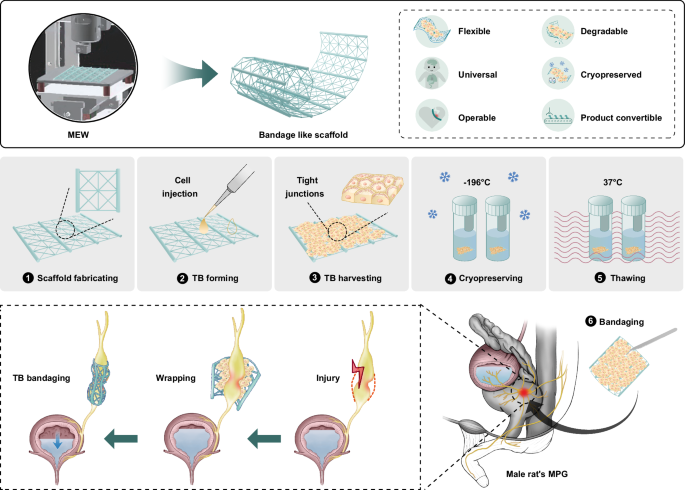Designed a tissue-like bandage for major pelvic nerve injury
Published in Biomedical Research

When the skin is injured, we usually use a band-aid for basic protection and healing. But what about nerve injuries? In response to this challenge, we employed the melt electrowriting technique to fabricate a bandage-like scaffold using FDA-approved polycaprolactone (PCL). This scaffold was integrated with cell therapy to develop a novel tissue-like bandage specifically designed for the treatment of pelvic nerve injuries. The objective of this approach is to minimize damage to the pelvic ganglia resulting from surgery or trauma.
This type of tissue-like bandage can effectively load cells and form a functional tissue-like structure, and its bandage design enhances the practicality of the scaffold, facilitating clinical application. Furthermore, the integration of cell therapy aids in promoting nerve regeneration and repair, thereby restoring the function of damaged nerves. We also found that the tissue bandage can be stored at low temperatures for over five months and still retain therapeutic efficacy upon revival.
Research results indicate that this type of tissue bandage, when applied in animal experiments, can significantly improve urinary function. Animals receiving this novel treatment exhibited better voluntary voiding and bladder emptying capabilities, demonstrating its notable efficacy in repairing pelvic nerve injuries. We discovered that the tissue bandage enhances the expression of cytoskeletal proteins within pelvic ganglia cells, thereby increasing resistance to mechanical damage. This not only provides a new approach for the treatment of pelvic nerve injuries but also lays the groundwork for further research in the field of neurobiology.
To our knowledge, the tissue-like bandage is the first effective method for treating pelvic nerve injuries. It boasts advantages such as flexibility, operability, biodegradability, low-temperature storage, and convertibility, making it a promising candidate for product translation. By effectively protecting the pelvic nerves, it aids in the early prevention of more severe injuries and alleviates bladder dysfunction caused by upstream ganglia damage.
In summary, the combination of the melt electrowriting technique with cell therapy in the tissue-like bandage demonstrates vast potential for application in nerve injury repair. The progress of this research represents a significant step forward in the field of nerve injury treatment, offering new hope for improving patients' quality of life.
Follow the Topic
-
Nature Communications

An open access, multidisciplinary journal dedicated to publishing high-quality research in all areas of the biological, health, physical, chemical and Earth sciences.
Related Collections
With Collections, you can get published faster and increase your visibility.
Women's Health
Publishing Model: Hybrid
Deadline: Ongoing
Advances in neurodegenerative diseases
Publishing Model: Hybrid
Deadline: Dec 24, 2025


Please sign in or register for FREE
If you are a registered user on Research Communities by Springer Nature, please sign in